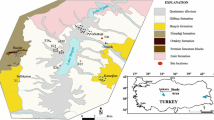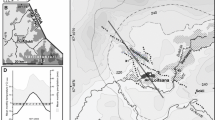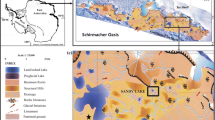Abstract
A 450 cm sediment core spanning the last 3,500 years was collected from 4.6 m of water in Lake Infernão, located in the floodplain of the Moji-Guaçu River in SE Brazil, to reconstruct the wetland system (river and lake) paleohydrology. A multidisciplinary approach using isotopic (13C and 15N), chemical (C/N ratio and lignin derived phenols) and physical analyses (% water content and density) were used in this study. A coarse sand unit in the lower part of the core (450–417 cm) corresponds to the paleoriver. The rest of the sediment core (dark clay) shows a gradual change from a fluvial to a lacustrine environment. 14C dates from the lower part of the core (417–200 cm), demonstrate an inversion and narrow span in age (3,000–3,500 yrs B.P.) corresponding to a period of rapid fluvial sedimentation and reworking. The lake seems to have been well established only after 3,000 yrs B.P. The change from a fluvial to a lacustrine environment is inferred from the isotopic and chemical data. Sediment of the fluvial phase is characterized by higher δ13C values, lower C and N content and a lignin content representative of woody-tissues. Sediment of the lacustrine phase show a gradual decrease in δ13C values toward the top of the core reflecting the influence of organic carbon derived by phytoplankton and aquatic macrophytes (C3 plants). The trend to higher C and N content and low C/N ratios also support this interpretation. The lower lignin content indicates increase contributions of non-vascular plants (phytoplankton). Similarly, the slight increase of non-woody tissues (higher C/V ratios) and the predominance of angiosperm plants (high S/V ratios) as organic matter source indicate an increase contribution of aquatic plants during the lacustrine phase. Our data presented here in addition to the geomorphological information and the available paleoclimatic scenario of pollen-inferred analyses for aquatic systems from the southeastern Brazil point to a climatic origin for this fluvial-lacustrine transition at about 3,000 yrs B.P. and to a climatic evolution leading to the present conditions and to a consequently gradual isolation of Lake Infernão from the influence of the Moji-Guaçu River.
Similar content being viewed by others
References
Albuquerque, A. L. S. & A. A. Mozeto, 1997. C:N:P ratios and stable carbon isotope compositions as indicators of organic matter sources in a riverine wetland system (Moji-Guaçu river, São Paulo, Brazil). Wetlands 17: 1–9.
Ballester, M. V. R., 1994. Emissões de metano na planicie de inundação do Rio Moji-Guaçu (Estação Ecológica de Jataí, Sao Paulo). Ph.D thesis. PPG-ERN. UFSCar, Sao Carlos, Brasil, 120 pp.
Behling, H., 1995. A high resolution Holocene pollen record from Lago do Pires, SE Brazil: Vegetation, climate and fire history. J. Paleolim. 14, 253–268.
Clapperton, C. M., 1993. Quaternary geology and geomorphology of South America. Elsevier, Amsterdam.
De Oliveira, P. E. 1992. A Palynological Record of Late Quaternary Vegetation and Climatic History in Southeastern Brazil. PhD Thesis. Ohio State University, Columbus, Ohio, 242 pp.
De Oliveira, P. E., A. M. F. Barreto & K. Suguio. 1999. Late Pleistocene/Holocene climatic and vegetational history of the Brazilian caatinga: the fossil dunes of the middle São River. Palaeogeogr. Palaeoclimatol. Palaeoecol. 152: 319–337.
Ferraz-Vicentini, K. R. & M. L. Salgado-Labouriau, 1996. Palynological analysis of a palm swamp in central Brazil. J. S. Am. Earth Sci. 9: 209–219.
Ferraz-Vicentini, K. R., 1999. História do Fogo no Cerrado: Uma análise palinológica. PhD Thesis. Universidade de Brasília, Brasil, 157 pp.
Gandolfi, N., 1968. Bacia do Rio Moji-Guaçu: morfometria da drenagem, sedimentologia e investigações físico-químicas. PhD Thesis. USP/EESC. Sao Carlos, Brasil, 124 pp.
Gandolfi, N., 1971. Investigações sedimentológicas, morfométricas e físico-químicas nas bacias do Moji-Guaçu e do Peixe. Geologia, 15. USP/EESC. Sao Carlos, SP, Brazil, 108 pp.
Hammarlund, D., 1992. A distinct 13C decline in organic lake sediments at the Pleistocene-Holocene transition in southern Sweden. Boreas. 22: 236–243.
Hammarlund, D., R. Aravena, L. Barnekow, B. Buchardt & G. Possnert, 1997. Multicomponent carbon isotope evidence of early Holocene environmental change and carbon-flow pathways from a hard-water lake in northern Sweden. J. Paleolim. 18: 219–233.
Hedges, J. I. & D. C. Mann, 1979. The characterization of plant tissues by their lignin oxidation products. Geochim. Cosmochim. Acta. 43: 1803–1807.
Hedges, J. I. & J. R. Ertel, 1982. Characterization of lignin by gas capillary chromatography of cupric oxide oxidation products. Anal. Chem. 54: 174–178.
Hedges, J. I., W. A. Clark, P. D. Quay, J. E. Richey, A. Devol & U. D. E. M. Santos, 1986. Compositions and fluxes of particulate organic material in the Amazon River. Limnol. Oceanogr. 31: 717–738.
Hollander, D., J. A. McKenzie & H. A. Lo ten Haven, 1992. A 200 year sedimentary record of progressive eutrophication in Lake Greifen (Switzerland): Implications for the origin of organiccarbon-rich sediments. Geology. 20: 825–828.
Ishiwatari, R. & M. Uzaki, 1987. Diagenetic changes of lignin compounds in a more than 0.6 million-year-old lacustrine sediment (Lake Biwa). Geochem. Cosmochim. Acta 51: 321–328.
Krusche, A. V. & A. A. Mozeto, 1999. Seasonal hydrochemical variations in an oxbow lake in response to multiple short-time pulses of flooding (Jataí Ecological Station – Mogi-Guaçu River, São Paulo, Luiz Antonio, SP-Brazil. An. Acad. Bras. Ci., 71(4-I): 1–14.
Ledru, M. P., 1993. Late Quaternary environmental and climatic changes in Central Brazil. Quat. Res. 39: 90–98.
Martin, L., J. M. Flexor & K. Suguio, 1995. Vibro-testemunhador leve: construção, utilização e potencialidades. Rev. IG, São Paulo 16(1/2): 59–66.
Mello, C. L., 1997. Sedimentação e Tectonica Cenozóicas no Médio Vale do Rio Doce (MG, Sudeste do Brasil) e suas implicações na Evolução de um sistema de Lagos. PhD Thesis. Instituto de Geociências, Universidade de São Paulo, Brasil, 275 pp.
Nogueira, F. M. B., 1992. Importância das macrófitas aquáticas Eichhornia azurea e Scirpus cubensis na ciclagem de nutrientes e nas principais características limnológicas da Lagoa do Infernão, SP. MSc Thesis. PPG-ERN. UFSCar, Sao Carlos, SP, Brasil, 95 pp.
Parizzi, M.G., 1993. Gênese e a dinâmica da Lagoa Santa com base em estudos palinológicos, geomorfológicos e geológicos de sua bacia. Master Thesis. Universidade Federal de Minas Gerais, Brasil, 103 pp.
Parizzi, M.G., M. L. Salgado-Labouriau & H. C. Kohler, 1998. Genesis and environmental history of Lagoa Santa, Southeastern Brazil. The Holocene 8(30): 311–321.
Polach, H. A., 1974. Application of liquid scintillation spectrometers to radiocarbon dating. In Staley, P. E. & B. A. Scoggins (ed.), Liquid Scintillation Counting, Recent Developments. Academic Press, Londons, 153–171.
Salgado-Labouriau, M. L., V. Casseti, K. R. Ferraz-Vicentini, L. Martin, F. Soubies, K. Suguio & B. Turcq, 1997. Late Quaternary vegetational and climatic changes in cerrado and palm swamp from Central Brazil. Palaeogeogr. Palaeoclim. Palaeoecol. 128: 215–226.
Salgado-Labouriau, M. L., M. Barberi & K. R. Ferraz-Vicentini, 1998. A dry climatic event during the Late Quaternary of tropical Brazil. Rev. Palaeobot. Palynol. 99: 115–129.
Santos, J. E. & A. A. Mozeto, 1992. Programa de análise de ecossistemas e monitoramento ambiental: Estação Ecológica de Jatai (Luiz Antonio, SP). Ecologia de Áreas Alagáveis da Planície de Inundação do Rio Moji-Guacu. Projeto Jataí. UFSCar. PPGERN. 59 pp.
Schelske, C. & D. A. Hodell, 1991. Recent changes in productivity and climate of Lake Ontario detected by isotopic analysis of sediments. Limnol. Oceanogr. 36: 961–975.
Schelske, C. & D. A. Hodell, 1995. Using carbon isotopes of bulk sedimentary organic matter to reconstruct the history of nutrient loading and eutrophication in Lake Erie. Limnol. Oceanogr. 40: 918–929.
Suguio, K., M. L. Absy, J. M. Flexor, M. P. Ledru, L. Martin, A. Siferdine, F. Soubies, B. Turcq & J. P. Ybert, 1993. The evolution of the continental and coastal environmental during the last climatic cycle in Brazil (120Ky to Present). Bol. Inst. Geosci. USP 24: 27–41.
Stuiver, M., & H. A. Polach, 1977. Reporting of 14C data. Radiocarbon. 19: 355–363.
Talbot, M. R. & T. Johannessen, 1992. A high resolution paleoclimatic record for the last 27,500 years in tropical West Africa from the carbon and nitrogen isotopic composition of lacustrine organic matter. Earth Planet. Sci. Lett. 110: 23–37.
Author information
Authors and Affiliations
Rights and permissions
About this article
Cite this article
Lobo, I., Mozeto, A.A. & Aravena, R. Paleohydrological investigation of Infernão Lake, Moji-Guaçcu River watershed, São Paulo, Brazil. Journal of Paleolimnology 26, 119–129 (2001). https://doi.org/10.1023/A:1011145227967
Issue Date:
DOI: https://doi.org/10.1023/A:1011145227967




